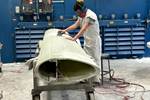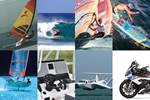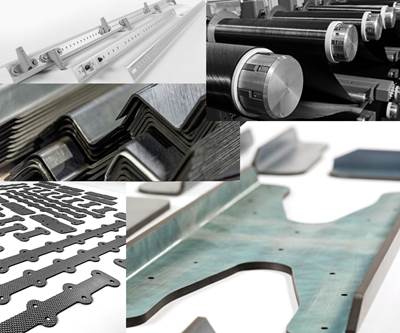A legacy of innovation in advanced thermoplastic composites
ATC Manufacturing, a 2024 Top Shops honoree, enables high-rate aerospace production with sustainable, lightweight and durable thermoplastic composite solutions.

ATC Manufacturing places focus on realizing the full potential of thermoplastic composites.
Source (All Images) | ATC Manufacturing
ATC Manufacturing (Post Falls, Idaho, U.S.) has been providing advanced composite solutions to the aerospace and defense industries for more than two decades. Founded in 2004 by former Boeing engineer Dan Jorgensen, the Idaho-based company strives to be a pioneer in the use of thermoplastic composites for aerospace parts and structures. Today, the company continues to specialize in continuous fiber thermoplastic composites, offering durable, lightweight and high-performance parts for a variety of aerospace applications.
“Our focus is on high-rate, cost-saving applications where thermoplastics can really shine,” explains ATC business development manager Jason Merrifield. “Picture stamping out a new part every few minutes versus laying up and curing parts; it’s a more efficient process.”
The company says its two core processes — continuous compression molding (CCM) and stamp forming — enable it to rapidly produce complex composite parts at a fraction of the labor costs associated with traditional thermoset layup and with reduced material waste. The speed and efficiency of these processes make them a good fit for a range of aerospace components from simple clips and brackets to larger structural parts and more complex assemblies. ATC has long-term agreements with Boeing for such components and works directly with Boeing as well as with the company’s Tier suppliers including Spirit Aerosystems and Leonardo.

ATC’s continuous compression molding capabilities can produce larger structural parts such as ribs and bulkhead components.
“When we talk about aerospace parts at automotive rates, thermoplastics are definitely a candidate for that because you can scale up quickly,” says Merrifield. “Anywhere you have a high volume of parts, that’s where thermoplastics really excel.”
In addition to clips and brackets, the company is capable of larger thermoplastic composite parts with longer profiles — parts that normally tend to be more expensive because they are often made of metal or thermoset materials.
“Ribs, control surfaces, bulkhead components, door surrounds — our CCM is capable of making long C-channels, I-beams and similar parts for those kinds of applications,” Merrifield says.
A focus on high-rate production, sustainability
The niche that ATC occupies is by design. The company was founded with the ambition to leverage advanced thermoplastic technologies to address the aerospace industry’s growing demand for stronger yet lighter materials. While traditional thermoset composites continue to be widely used in the industry, they continue to present limitations in terms of recyclability and high-rate scalability. Thermoplastics offer an alternative — a material that can not only meet aerospace specifications, including weight reduction and strength, but also provides a path to optimized production and sustainability. Merrifield explains that thermoplastic composites processing is naturally high-rate due to short cycle times.
From its inception, ATC’s goal was to optimize production efficiency, reduce production times and reduce costs without compromising quality. This motivated early strategic investments in the latest automated systems and developing in-house expertise in composite forming techniques. Now, the company operates a 67,000-square-foot-facility equipped with automated assembly lines, precision molding tools and advanced testing laboratories. It offers a range of services, including custom tooling design and high-volume production via CCM and stamp forming. Additional operations include CNC trimming and finishing, and quality inspection including nondestructive inspection (NDI) and R&D.
ATC Manufacturing is AS9100 and Nadcap certified. The company is International Traffic in Arms Regulations (ITAR) compliant and working toward the Cybersecurity Maturity Model Certification (CMMC) and Controlled Unclassified Information (CUI) certification.
A vision for the future
While aerospace remains the core of ATC’s business, the company does have an eye on new markets and is always seeking ways to further leverage the potential of thermoplastics. This includes emerging markets like urban air mobility (UAM), where the combination of high-production rates and stringent aerospace requirements play directly to the company’s strengths. Within the UAM sector, the company is looking to such applications as ribs, control surfaces, structural beams and brackets, as well as structural elements for such applications as seatback components.
ATC is also investing in research to improve the performance characteristics of thermoplastic composites, making them even more versatile for next-generation aerospace and industrial applications. The company is engaged with industry groups like the , Thermoplastic Composites Research Center (TPRC), Society for the Advancement of Material and Process Engineering (SAMPE) and the American Composites Manufacturing Association (ACMA). Merrifield says these collaborative platforms help ATC stay ahead of the latest material and process developments. The company also uses tools like CW’s Top Shops Benchmarking Survey, which it has been participating in for 5 years, to aid in its continuous improvement practices and to also gain insights into its performance in relation to its peers in the industry.
“These groups provide a good collaboration environment where we can see what the industry is looking at and what customers are looking for when it comes to thermoplastics so we can position ourselves to be ready to take on some of that work,” Merrifield says. Much of that work ahead involves education and validation of the benefits of thermoplastics and overcoming misconceptions about what is possible.
“We try to collaborate at early stages in the project where we can influence the design from the start, rather than influence after the fact,” says Merrifield. “The same fibers that you have in a thermoset, you can have in a thermoplastic. T700s, T1100s — all the standard modulus and intermediate modulus — all those fibers are still available, as well as woven fabrics. The playing field is a little bit more even than you might think.”
As ATC looks forward, Merrifield says the focus is both on growing its business and influencing the broader industries it serves to shape the future of how thermoplastic composites are leveraged. By embracing automation and digitalization, the company aims to continue setting benchmarks in precision and scalability.
“We’re not just a shop — we’re actively involved in pushing the technology forward,” Merrifield says. “We know thermoplastics aren’t the answer for every application, but wherever speed, cost and performance are critical, we believe they have a real competitive edge.”
Related Content
MFFD longitudinal seams welded, world's largest CFRTP fuselage successfully completed
Fraunhofer IFAM and partners have completed left and right welds connecting the upper and lower fuselage halves and sent the 8×4-meter full-scale section to ZAL for integration with a cabin crown module and testing.
Read MoreDevelopment of a composite liquid hydrogen tank for commercial aircraft
Netherlands consortium advances cryogenic composites testing, tank designs and manufacturing including AFP, hybrid winding, welding of tank components and integrated SHM and H2 sensors for demonstrators in 2025.
Read MoreCo-molding SMC with braided glass fiber demonstrates truck bed potential
Prepreg co-molding compound by IDI Composites International and A&P Technology enables new geometries and levels of strength and resiliency for automotive, mobility.
Read MorePlant tour: Airbus, Illescas, Spain
Airbus’ Illescas facility, featuring highly automated composites processes for the A350 lower wing cover and one-piece Section 19 fuselage barrels, works toward production ramp-ups and next-generation aircraft.
Read MoreRead Next
Accelerating thermoplastic composites in aerospace
ATC Manufacturing produces millions of thermoplastic composite parts per year, and is investing for future growth.
Read MoreDefense manufacturer reflects on growth, opportunity in complex composite structures
Long Island-based, four-time CW Top Shops honoree GSE Dynamics cites diversification in processes, digitalization, workforce training and more on its successes over 50+ years, and looks ahead to future growth.
Read MoreWatersports manufacturer diversifies into new markets, processes
CW Top Shops honoree Cobra International reflects on its growth over 45+ years, as well as current work expanding its automotive and UAV capabilities, increasing energy efficiency and new SMC production lines.
Read More












